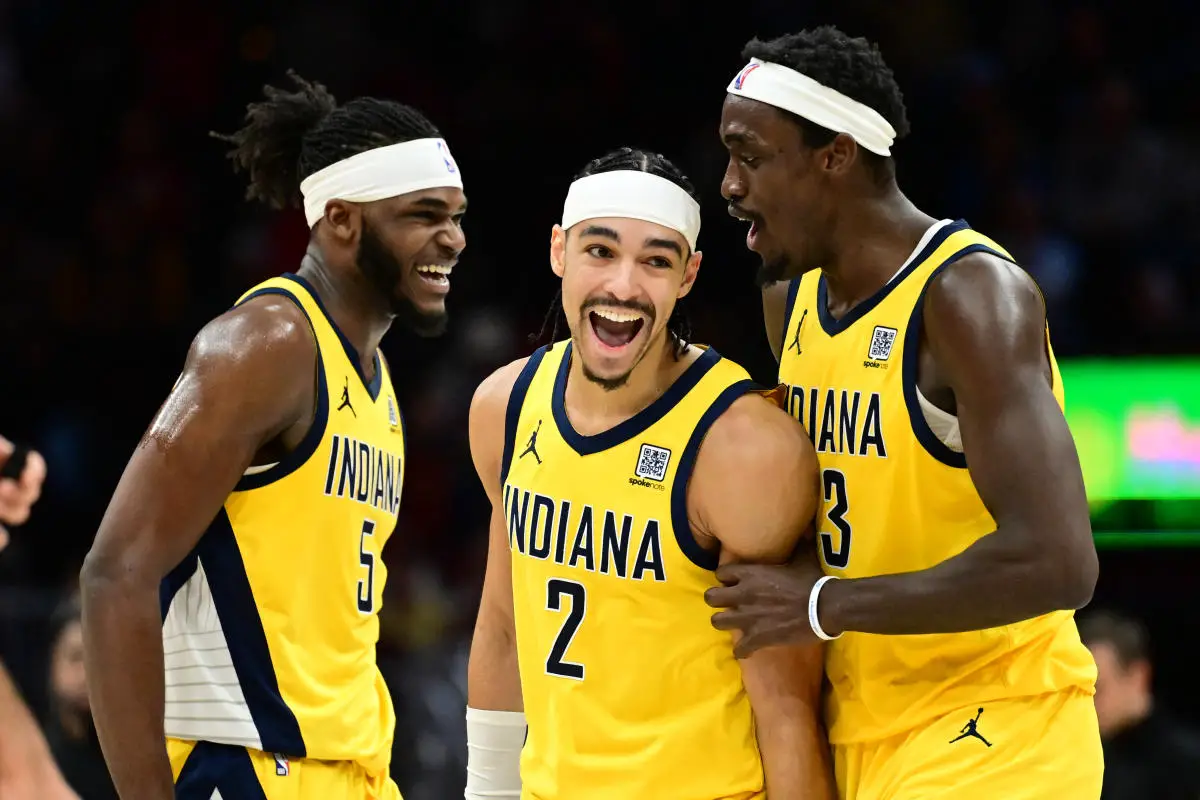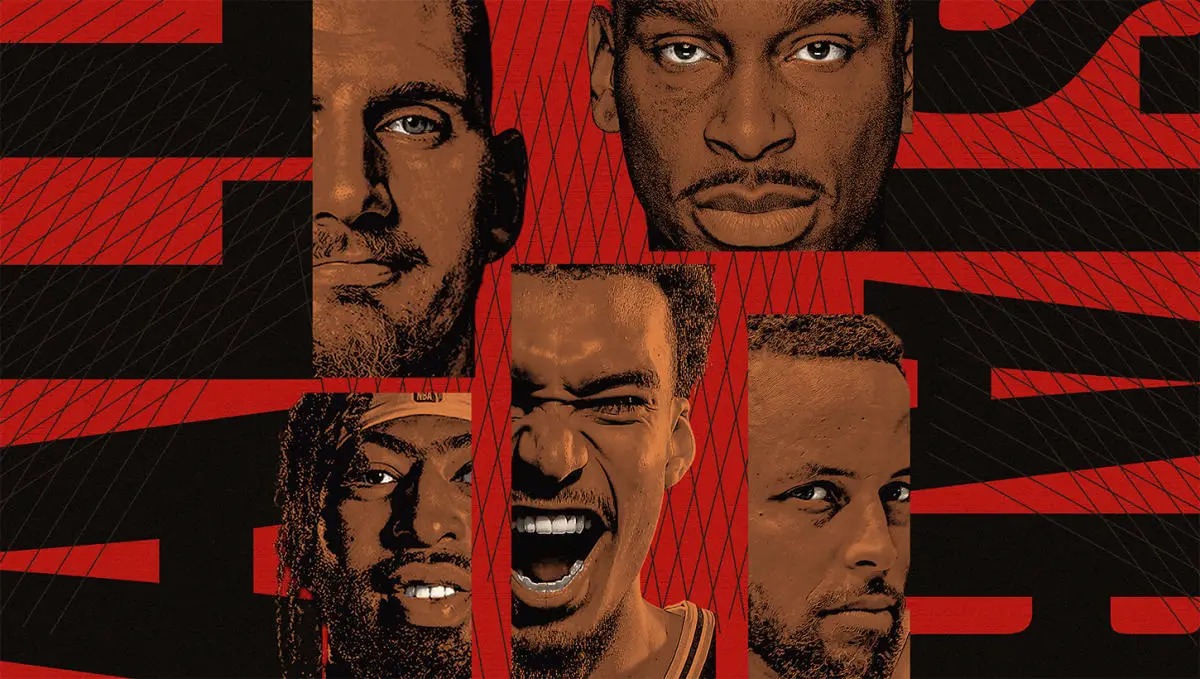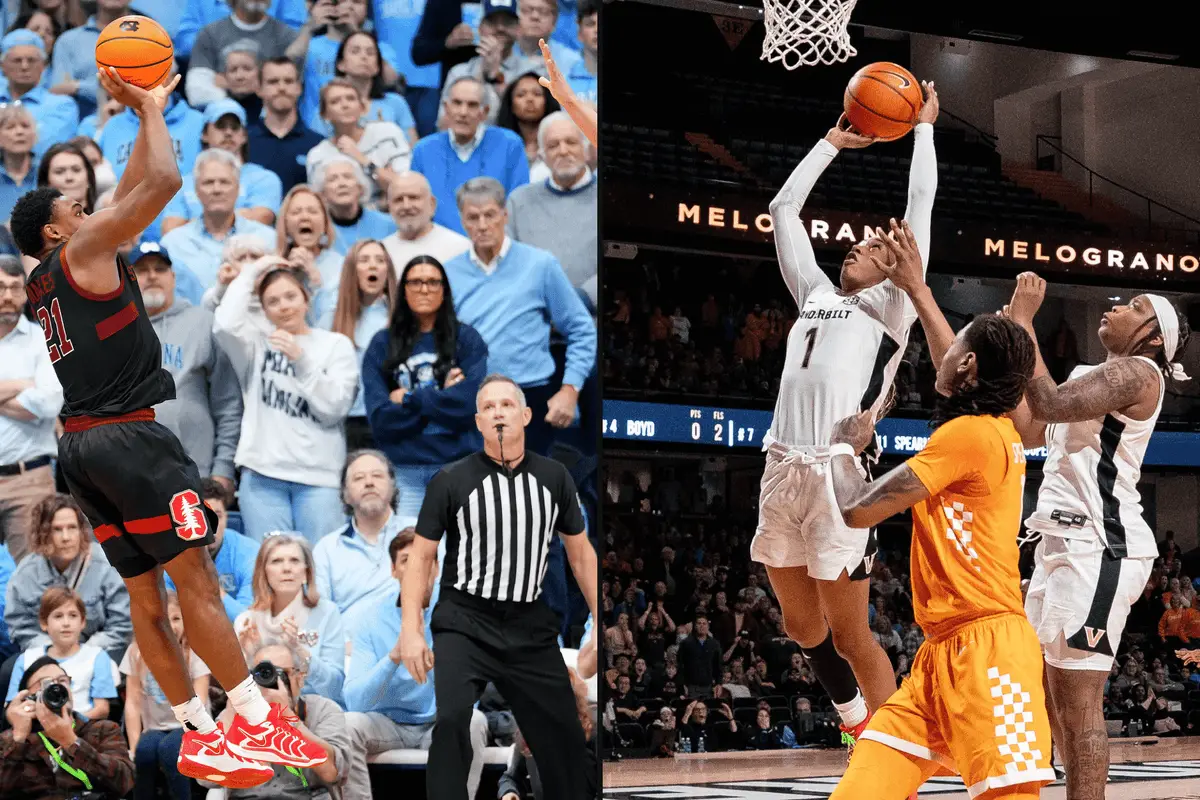
[ad_1]
Back in September, one of the most interesting questions on the board was what the Pacers had in store as an encore to build on their breakneck, breakthrough 2023-24 season. Twenty-five games into the new campaign, though, the answer appeared to be, “Um, not much.”
The Pacers sat a dismal 10-15, about as close to last place in the East as they were to the top four. The league-leading offense that had carried Rick Carlisle’s club all the way to the Eastern Conference finals had plummeted near the bottom third of the NBA; the permissive defense that offense had to carry like a grudge sunk even further, a bottom-five anchor. They dropped games to would-be Flagg capturers in Toronto, Brooklyn and Charlotte — a level of struggle that prompted All-NBA point guard Tyrese Haliburton to say, “The product we’re putting on the floor right now as a group is embarrassing.”
What a difference a month makes.
Since early December, Indiana has been one of the NBA’s hottest teams, winning 12 of its last 15 and six straight — the second-longest current winning streak in the NBA, and the longest string of double-digit wins in franchise history — capped by an impressive win over the NBA-best Cavaliers on Sunday. The Pacers enter Tuesday’s nationally televised rematch with Cleveland at 22-18 — just a half-game out of fourth place in the East, and a long way from “embarrassing.”
The only teams with a better record than the Pacers over the past five weeks are the Cavs team they just beat and the Thunder, whom they recently took down to the wire. Only Denver has a higher team field goal percentage in this span, nobody’s got a better assist-to-turnover ratio, and only Cleveland and Denver have been better on offense than the Pacers, who have scored 119.4 points per 100 possessions outside of garbage time over their past 15 games, according to Cleaning the Glass.
That’s not quite as high as the clip at which they scored last season, when they joined the Celtics in rewriting the offensive record books. But it’s significantly closer than they were during the disappointing start that led some to wonder if the clock had struck midnight on last season’s Cinderella.
That start came amid a raft of early-season injuries. Indiana lost both of its backup centers, James Wiseman and Isaiah Jackson, to ruptured Achilles tendons in the opening week. Starting small forward Aaron Nesmith, Carlisle’s best (and often only) defensive option against the league’s best big wings, has been shelved since November 1 with a nasty ankle sprain. Haliburton’s backcourt partner, Andrew Nembhard, missed a month with left knee inflammation; his backup, Ben Sheppard, missed a month with a strained left oblique.
Even down half a rotation, though, you only get so much grace in a bottom-line-based business … especially when your highest-paid and highest-profile players are still in the lineup, and have largely performed.
Forward Pascal Siakam has merited All-Star consideration for his rock-solid play, averaging a team-high 19.9 points and 7.4 rebounds per game while shooting 52% from the field and a career-high 41% from 3-point land. Center Myles Turner has continued to function as a minor-key unicorn, one of just three players in the NBA with at least 70 blocks and 70 3-point makes. The Pacers have gone 13-5 with the starting lineup of Haliburton, Siakam, Turner, Nembhard and Bennedict Mathurin — a quintet that has played the fourth-most minutes of any unit in the NBA this season and has outscored opponents by 125 points in 324 minutes, a whopping 18.1 points-per-100.
It’s Haliburton, though, who charts Indiana’s course — and, again, whose ebbs and flows come into focus in context.
Haliburton’s heroics
There’s no one reason why the 24-year-old shot just 38% from the field and 29% from 3-point range in the opening month. Some of his struggles likely stemmed from the hamstring and back-spasm issues that plagued him last season, which he aggravated in the playoffs and reportedly reaggravated during the Olympics. Defenses also deserve plenty of credit for forcing him to fight through the extra attention that comes as the price of All-Star status, with Haliburton not only seeing every team’s top stopper night after night, but often dealing with aggressive face-guarding and full-court pressure designed to force him off the ball.
Some of the blame falls at Haliburton’s own feet — for being too willing to let those defenses dictate his level of engagement, for the lapses in aggression that can leave Indiana looking listless, and for succumbing to creeping suspicion.
This embedded content is not available in your region.
“I got too caught up in outside noise and allowing myself to think such negative thoughts about myself internally,” Haliburton recently told The Athletic. “It was the first time in my life that I had real self-doubt behind everything I was doing. … I feel like my personal struggles were leading to the team’s struggles.”
If that’s true, though, so is the inverse. When Haliburton looks more like his aggressive self, the Pacers can trade haymakers with anyone — like when he scored 31 points and dished seven assists without a turnover, shooting 10 for 13 inside the arc with nine free-throw attempts, in an impressive road victory in Boston.
Since his rocky start, Haliburton has largely returned to form, averaging 20.7 points and 9.2 assists per game on 49/41/88 shooting splits since the opening month of the season prior to leaving the win over Cleveland early after reaggravating that left hamstring. More important than his individual production, though, is the impact he’s had on the Pacers’ attack on the whole; Indiana has been a top-10 offense since that opening month, and has scored 18.5 more points-per-100 with Haliburton on the floor than off of it.
Even in an up-and-down start, Haliburton remains one of the league’s premier playmakers, ranking in the top five in the NBA in assists per game, assist-to-turnover ratio and points created via assist. Including plays where he passes after taking a screen rather than looking to finish himself, Haliburton’s pick-and-rolls have produced 1.195 points per possession for the Pacers, according to Synergy — the third-highest mark out of 116 players to have run at least 100 such plays.
Indiana has listed Haliburton as doubtful for Tuesday’s rematch with Cleveland — a considerable bummer. It’s slightly less of one, though, considering we just saw the Pacers erase a 15-point third-quarter deficit against Cleveland without him … and, perhaps most notably, doing it largely by turning the screws defensively, holding the NBA’s most devastating offense to just 40 second-half points.
Indy’s secret weapon
That the Pacers have found their level on offense, while vital, isn’t shocking. What does raise your eyebrow, though? Indiana has only allowed 109.3 points-per-100 during this run — a top-five defensive mark.
“We’re starting to care more,” Turner recently told reporters. “We went through a stretch last season where we kept on saying the same thing, ‘We gotta defend, we gotta defend.’ But I think now we’re putting those words into actions.”
You see it in the way Indiana’s been limiting second-chance opportunities, improving from 16th in defensive rebounding rate to fourth over their last 15 games. (Mathurin’s been notable in that effort; seen largely as a score-first player through his first two seasons, he’s pulling down 16.3% of available defensive rebounds this season, a top-20 mark among wings.) You see it in how the Pacers are moving their feet; they’re third in distance covered on defense, according to Second Spectrum, and fourth in average speed on defense. You see it in how they’re contesting without fouling, allowing four fewer free-throw attempts per 100 possessions. And you see it in how they’re creating virtuous cycles.
Talk to coaches for long enough, and they’re liable to remind you that the two ends of the court are connected — that offense and defense are not discrete entities, but rather that they flow from and into one another. Get more stops and corral more rebounds, and you’ll get more opportunities to run. During this 12-3 stretch, transition plays have accounted for 17.2% of the Pacers’ offensive possessions, a leap over even last season’s top-10 share; they’re scoring a blistering 139.3 points-per-100 on them, miles ahead of their (still-excellent) half-court efficiency.
And when you make more shots and commit fewer turnovers yourself, you limit the opponent’s opportunities to run. Just 10.9% of the Pacers’ defensive possessions in this stretch have come in transition, the fewest in the NBA; when they’ve been able to set their defense, the Pacers have allowed just 92.5 points-per-100 in the half-court, fourth-best in the NBA in this span.
Better possessions beget better possessions beget better possessions … and as impressive as Haliburton and Siakam have been, the biggest swing factor in whether Indiana generates good possessions might be someone else.
Nembhard’s individual numbers are relatively modest: 12 points, 4.9 assists and 3.8 rebounds in 28 minutes per game since coming back from injury, shooting 50% from the floor, 37.5% from 3-point range and 80.9% from the free-throw line. His impact, however, is not. The Pacers are 18-7 with Nembhard in the lineup, a 59-win pace; they outscore opponents by 12 points-per-100 with him on the floor.
The Pacers locked Nembhard up with a three-year, $59 million contract extension this summer because they knew some in the NBA-watching world are just figuring out — that he’s a force multiplier, a fixer, a do-it-all connector whose presence bridges gaps on offense and plugs them on the other end.
“His impact is immeasurable,” Turner recently told reporters. “He goes out there and guards their best players and he’s putting pressure on the rim. He makes tough shots and he’s someone that is very valuable to our team.”
Nembhard’s return gives the Pacers another high-caliber ball-handler next to Haliburton, helping cut their turnover rate from 14.8% of their offensive possessions through the first six weeks to a league-best 11.9% during this run. It also puts another quality shooter on the floor, helping improve the Pacers’ spacing and (slightly) boost the share of Indiana’s shots that come from deep.
He’s also Indiana’s best point-of-attack defender, taking the nightly assignment on the opponent’s top backcourt scoring threat; during the winning streak, he’s drawn the primary matchup on Donovan Mitchell, Zach LaVine, Devin Booker and Tyler Herro, and that’s par for the course. He ranks in the 99th percentile in the NBA in average matchup difficulty, ball screen navigation and perimeter isolation defense, according to The BBall Index, and in the 98th percentile at chasing opponents off the ball. The only other player in the NBA that high in all four categories? Nembhard’s Canadian countryman, Oklahoma City cinderblock Luguentz Dort.
Elite defensive play by Andrew Nembhard.
Sprints between guarding three different players, forces pass out of post, then sprints to intercept + save pass on weak side.
Just superb. pic.twitter.com/GkrCVP0QUQ
— Scott Agness (@ScottAgness) January 9, 2025
That individual stinginess has downstream effects for Indiana’s team defense. Better ball pressure and perimeter containment lead to a better defensive shot profile. The Pacers give up fewer shots at the rim and from beyond the arc with Nembhard on the floor, and have jumped from 25th in the NBA in up-close attempts allowed before this run to the middle of the pack over the last 15 games.
Better containment helps keep teammates out of rotation, which keeps more bodies near the basket. The Pacers haul in 75.5% of available defensive rebounds with Nembhard on the court, a rate that would lead the league for the full season. Better coverage on the perimeter and the glass allows Turner to focus on protecting the rim; he’s holding opponents to 53.7% shooting at the basket in the last 15 games, eighth-best among high-volume interior defenders. (The Pacers have also been winning the minutes with Thomas Bryant — acquired last month to replace the injured Wiseman and Jackson, and to minimize how often they had to play small with Obi Toppin at center — taking Turner’s place.)
It all adds up to Nembhard — the fifth option in the starting lineup, not exactly a household name outside of Indianapolis, Spokane or the GTA — having not only the best on-court/off-court splits on the team, but very nearly the league’s best. According to Cleaning the Glass, the Pacers have been an astounding 17.8 points-per-100 better with Nembhard on the court than off it this season. That’s the second-largest differential among all players to log at least 200 minutes. The only dude with a better one? Nikola friggin’ Jokić.
Can they keep pace in the East?
Nembhard’s return, Haliburton’s resurgence, Siakam’s consistency and energetic play from the reserve corps of Toppin, Sheppard, Bryant, T.J. McConnell and Jarace Walker have all played major roles in driving the Pacers’ rise. They’ve also gotten some breaks along the way: This 12-3 jolt has included wins over the injury-ravaged Pelicans and the not-ready-for-prime-time Nets, the Celtics without Kristaps Porzingis and Jrue Holiday, the Heat mid-Jimmy Butler saga, and the Warriors without Stephen Curry, Draymond Green and most of the rest of their rotation. (It also included Joel Embiid suffering a sinus fracture in the middle of the game and exiting early.)
Opponents have underperformed their shot quality against Indiana in this stretch, shooting just 33.5% from long distance. Shooting variance is notoriously fickle; it’s reasonable to conclude that the Pacers have gotten a little lucky of late. It’s also reasonable, though, not to begrudge Indiana some good fortune after losing more player games to injury than all but six teams in the first half of the season — especially considering the evident effort that’s gone into generating it.
Whether the Pacers can keep this up remains to be seen. (Haliburton’s hamstring looms large.) This rollicking run, though, inspires fresh hope that the thrilling team we saw last season isn’t dead and gone, that the race for Eastern supremacy might yet have another entrant, and that there’s still time for the Pacers to author the kind of encore that sends the crowd home delirious.
[ad_2]
Source link






